Iran
Things to DO
Around Shiraz
Most visitors stay in Shiraz in order to visit the Bishapur and Persepolis, which will cost at least two days.
Bishapur and the nearby rock reliefs of Tang-e Chogan are located 135 km west of Shiraz off the Kazarun road.
Others then Kazerun (whitch is 20 km before Bishapur) there is no place to buy lunch in this area, so take the bulk of a picknic
whith you and buy fresh bread "en Route".
Persepolis and the nearby rock reliefs of Naqsh-e Rajab and Naqsh-e Rostam are about 50 km north-east of Shiraz.
Be Aware It can be verry cowded at Persepolis; so go there early, the opening time is 08:00.
Bishapur
According to an inscription, the city itself was founded in 266 by Shapur I (239-270 AD), who was the second Sassanid king and
inflicted a triple defeat on the Romans, having killed Gordian III, captured Valerian and forced Philip the Arab
to surrender. In his native province of Fars, he built a new capital that would measure up to his ambitions: Bishapur,
"Shapur's City".
The city remained important until the Arabian invasions and the rise of Islam in the second quarter of the 7th century.
There were still people living there in the 10th century.
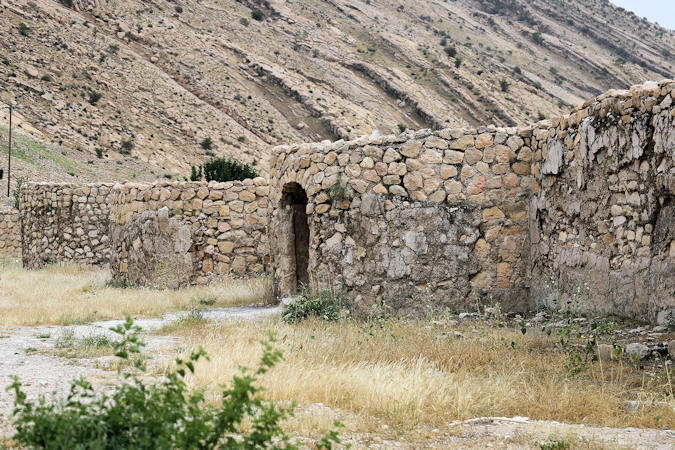 |
|||||
The most important point about this city, is the combination of Persian and Roman art and architecture that hadn't been seen before.
Before Bishapur was built, almost all the main cities in Persia had a circular shape; Bishapour is the first Persian city with vertical
and horizontal streets. Also in the city, especially in interior design, we can see tile work that's adapted from Roman Art
On entering the site, there are Sasanid walls surviving up to 3 m high with solid round towers.
The place has a rather desolate air as it was stripped bare of all its sculptures, mosaics, decorative plaster and other treasures; most
went to the Louver, Paris.
The main building, some 20 m2 with its stepped cruciform plan and four huge "ivans" (portals), probably functioned as the
Royal Audience Chamber.
There is an intriguing building to the north with high-quality, honey-coloured ashlar stone work. The staircase down is restored but 15 m of
the original walls remain, forming four faces of a central courtyard, with a covered ambulatory behind.
This was probably a Temple to Anahita, the Zoroastrian deity associated with battle, fertility and water.
Two nine-meter Memorial Pillars are standing in the center of the city ; between the pillars used to be a statue of Shapur I, which
has been gradually destroyed through the years.
Tang-e Chogan
The historical Tang-e Chogan is located near the ancient city of Bishapur. The Shapur River flows northeast to southwest through the
gorge (Tang-e) at a key intersection of trade routes in southwestern Iran.
The Sasanian kings lavished resources on public monuments proclaiming their relationship to their gods and their military victories.
This gorge has 6 reliefs related to Shapur I / II and Bahram I / II.
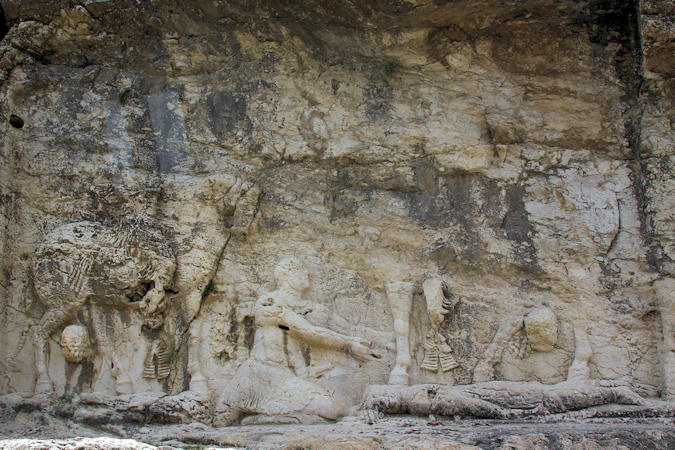 |
|||||
The badly damaged 1st relief on the left side of the river, depicts the Investiture of Shapur I (239-270 AD) receiving the
"Fareh- Izadi" (the royal ring) from Ahura Mazda, as well as his victory in the war against the Romans.
Under Ahura Mazda’s horse feet, the "Ahriman" (the devil) is lying and beneath Shapur’s horse’s feet is the corpse of
"Gordianus".
The second bas relief, is the best preserved one amongst the six and portrays the Glorious Victory of Shapur I versus three Roman
emperors; Gordian III’s (238–244) corps under his horse’s feet, Valerian (253–260) captivated, and Philip the Arab
(244–249) kneeing and kneeling and asking for peace and to bring back the body of the deceased young emperor.
The third of Shapur I’s reliefs proclaiming his victory over the Romans. Shown in its setting on the right bank of the river.
The image in the middle is a large composite from across the river.
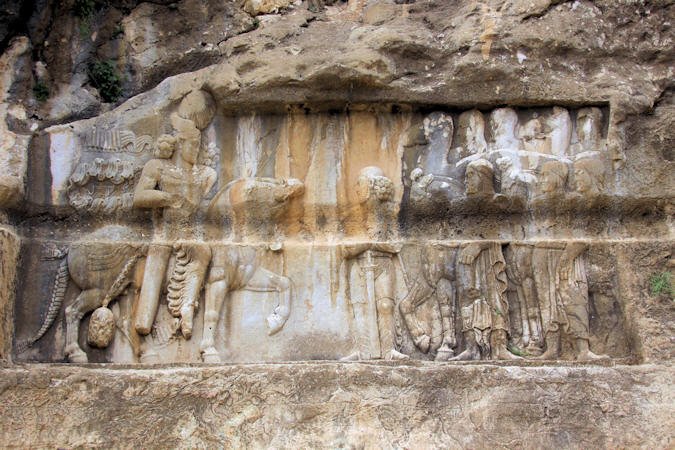 |
|||||
The fourth relief illustrates Bahram II’s (274–293 AD) victory over Arabs of the desert. Arab sheikhs, accompanied by Iranian
generals, paying tribute and presenting him horses and camels.
The 19th-century irrigation pipe cut through the middle of the relief.
The fifth bas relief, is a classical representation of an investiture, this time of king Bahram I (271–274 AD).
From the left, the supreme god Ahura Mazda approaches the king and gives him the ring of power, the cydaris.
There is a diadem tied to it. To the right, we see Bahram accepting the cydaris.
The details are amazing. You can see the wrinkles of their trousers and the blood veins on the horses feet and all proportions are
harmonious.
The last bas relief depicts Shapur II (309-379 AD) sitting on his throne, in front-on portrait, Iranian generals and soldiers standing
on his right side, and the captivated rebellions are brought to him by Sassanid soldiers on his left.
Persepolis
According to archeological evidence the earliest remains of Persepolis date to around 518 BC, four years after Darius the Great's
accesion to the Acheamenid throne. His successors added further buildings, but the site was still unfinished when, in early 330 BC.
Alexander the Great burned it to the ground after looting the city, seven years before his death.
It took him, according to Plutarch, 10.000 mules and 5.000 camels to carry away the booty from this revenge attack for the Achaemenid firing
of Athens. The complex consisted of military quaters, treasury stores, small private rooms and huge reception areas, but the exact function
of the complex remains an intriguing mystery.
On the evidence of low reliefs showing visitors bearing gifts, and lions attacking bulls, many assume Persepolis was used once a year to
celebrate Nou Rouz (Iranian New Year) but such festivities are not mentioned in Achaemenid and later sources.
There seem to have been only two occasions when the Achaemenid ruler received gifts; on the official imperial birthday and the annual
sacrifice to Mithra (god of light, purity, goodness, and truth).
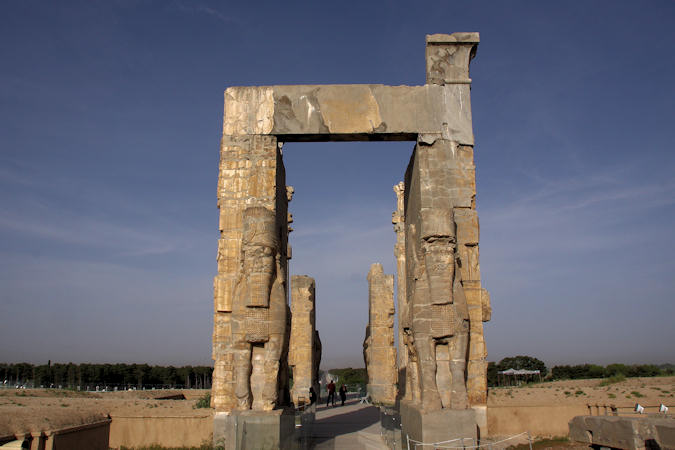 |
|||||
The Gate of All Nations, was protected by bulls (front) and mythological creatures, called "lamasssus", bulls with the head
of a bearded man. The general idea behind these fantasy animals is that they warded off evil, which explains why they were standing at a gate.
Army road; although this project remained unfinished two large capitals representing the heads of an eagle-griffin were ready. These
capitals, regarded as early representations of the "Huma bird", have become the symbol of Iran Air.
Hall of Hundred Columns was Persepolis' second largest building; At an unknown moment, its function was changed and it became
a store room, probably because the Treasury had become too small to contain all treasures that had been hoarded in Persepolis.
The entrances themselves were decorated with the usual motifs: audience scenes, throne scenes, and "royal warriors" fighting against
wild animals.
 |
|||||
The Apadana or "Audience Hall" belongs to the oldest building phase of the palace complex, the grand design by
it founder, king Darius I the Great (522-486 BC).
In this large hall, the great king received the tributes from all the subjects in the Achaemenid Empire, and gave presents in return.
The gift exchange mechanism was one of the central elements in the Persian royal ideology, and the Apadana was, therefore, one of the most
important symbols of the great king's power.
One of the arguments to assume that this was indeed the function of the Apadana, is the splendid relief on the eastern stairs, which consists
of representations of all nations in the empire.
The Hall, the largest and probably most beautiful of the buildings at Persepolis, could accommodate hundreds of people.
The original 72 columns, of which only 13 remain, were styled as animal sculptures of two-headed bulls, lions and eagles and where joined
by oak and ceder beams.
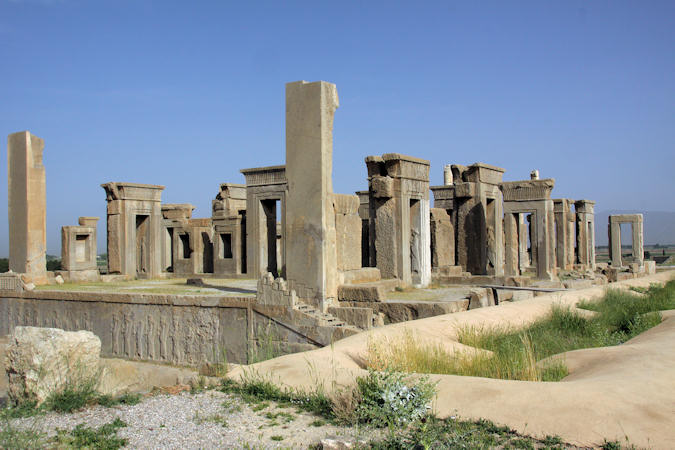 |
|||||
Winter Palace of Darius is entered by a western staircase decorated with figures of servants carrying food, vessels and
lambs.
An interesting innovation can be found on the lintels. They are made in an Egyptianizing style, which inspired later generations.
In front of the hillside, low walls mark the Treasury buildings where tens of thousends of clay tablets were unearthed, recording,
among other things, the numbers, nationalities and wages of the palace labourers.
It's main feature today is the central relief panel from the eastern apadana staircase, moved here in late Achaemenid times.
The damaged panel shows an enthroned Achaemenid emperor, perhaps Darius I or Xerxes holding the royal staff and a lotus flower. Behing
him are the crown prince, a court eunuch and an official, while in front a general pays homage.
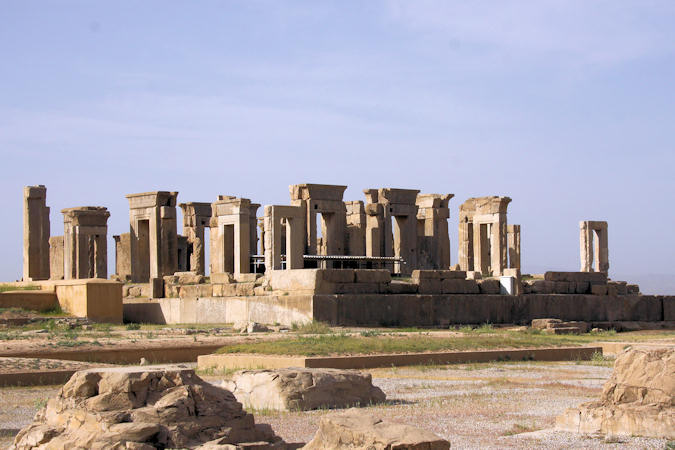 |
|||||
The Palace of Artaxerxes III (359-338 BC) is entered from staircases carved with further figures of delegates and attendants.
The baddly ruined Palace of Xerxes (486-465 BC), called "Hadish" had thirty-six columns and was surrounded by six smaller rooms:
three to the east and three to the west.
The Tripylon ("triple gate") consists of a central room with approaches to the north, east and south.
One of the buildings of Queen's Quarters has been more or less reconstructed and is now in use as a museum and as the office of the
Persepolis archaeological complex.
Naqsh-e Rajab
The natural state of the rock is like a canopy. It is said that in this place a person named Rajab had a coffee house and that is why
these Sassanid reliefs are known as Naqsh-e Rajab.
Only since late 2001 has the metal fence been erected. The ticket booth is occasionally unmanned and locked, as is the gate.
Exactely why theese important Sasanid investure reliefs are carved here is unclear.
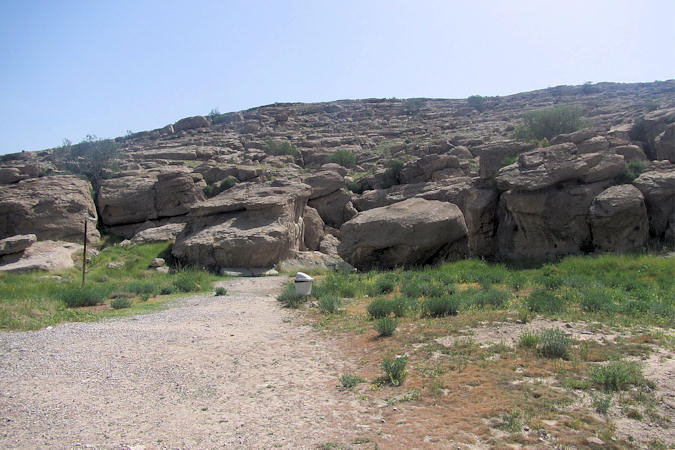 |
|||||
Investiture of Ardeshir I (224-239 AD), the founder of Sasanid Empire is considered to be the oldest relief.
Ardeshir I receiving the wreath of power from Ahura Mazda with his right hand, and kept his left forefinger raised as a sign of
respect, with an adorned crown on his head is seen.
Investiture Relief of Shapur I (239-270 AD) showing Shapur I on his horse, receiving the wreath of power from Ahura Mazda,
with his left hand kept on his sword. King`s face and hand details is faded.
Shapur I and his companions shows Shapur I on a large horse and nine of the country’s elders and noblemen stand behind him.
Kartir`s Inscription shows Kartir, the great priest of the early Sasanid period accompanied by a long inscription in Middle Persian
which describes the priest's rise to power during the time of Bahram II (274-293 AD)
Naqsh-e Rostam
Naqsh-e Rostam is an ancient necropolis situated northwest of Persepolis, the capital of the Achaemenid Empire.
Naqsh-e Rostam is an impressive reminder of once glorious Achaemenid Persian Empire (550–330 BC) and it stands as a magnificent
manifestation of ancient Persian art.
Naqsh-e Rostam is the house for the immense rock tombs cut high into the cliff. The rock tombs belong to four Achaemenian kings.
The facades of the tombs include large panels over the doorways, each very similar in content, with figures of the king being invested by
a god, above a zone with rows of smaller figures bearing tribute, with soldiers and officials.
The entrance to each tomb is at the center of each cross, which opens onto a small chamber, where the king lay in a sarcophagus.
One of the tombs is explicitly identified as the tomb of Darius I (522-486 BC). The other three tombs are believed to be those
of
Xerxes I (486-465 BC), Artaxerxes I (465-424 BC) and Darius II (423-404 BC).
The ancient tombs attracted Sasanian kings as well. They wished to imitate the glory of the Achaemenian kings; maybe that is why they
created huge reliefs besides the tombs. The immense rock reliefs mainly depict the investiture scenes and the equestrian fights of the
Sasanian kings.
However, the history of Naqsh-e Rustam is not limited to the Achaemenid and Sassanid periods. There is evidence that the site exists
from the Elamite period. An ancient rock relief dating back to Elamite period indicates that Naqsh-e Rostam had been a sacred
place during the ancient times.
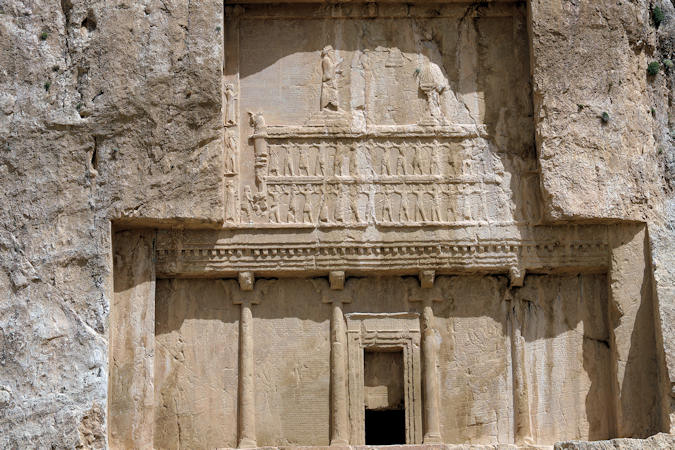 |
|||||
In front of the rock tombs, there is a square tower known as the
Ka’ba-ye Zartosht that means the "Cube of Zoroaster"
It might have been a library for the holy books, a place to keep the holy fire, or maybe a treasury.
Investiture relief of Ardashir I, (224–239 AD); The founder of the Sassanid Empire is seen being handed the ring of kingship by
Ahura Mazda.
He more or less admitted that he had been a rebel and had betrayed his master Artabanus IV; the last ruler of Parthian Empire,
but he claimed, he had done so because the supreme god Ahura Mazda had wanted him to do so.
Audience relief of Bahram II, (274–293 AD); On each side of the king, who is depicted with an oversized sword, figures face the
king.
On the left, stand five figures, perhaps members of the king's family. On the right, stand three courtiers, one of which may be Kartir.
Elamite relief; The oldest monument at Naqš-e Rostam is not fully understood but believed to of Elamite in origin. It may date back
to the eighth century BC.
The original relief was considerably larger but a very large part of it was later removed when the Sasanian King Bahram II ordered the
making of his audience relief. A small figure with a remarkable cap, vaguely resembling a dwarf, is still visible.
 |
|||||
The first Equestrian relief of Bahram II, (274–293 AD), depicts the king battling a mounted Roman enemy.
The second equestrian relief of Bahram II, is divided into two registers. In the upper register, the king appears to be forcing a Roman enemy,
probably Roman emperor Carus from his horse. In the lower register, the king is again battling a mounted enemy.
On both reliefs, a dead enemy is trampled upon by the king's horse. The enemy cannot be identified.
Equestrian relief of Hormizd II, (303–309 AD); It shows how king Hormizd unhorses an enemy, who may be identified with king
Papak of Armenia
Triumph of Shapur I (239–270 AD); This is the most famous of the Sassanid rock reliefs, and depicts the victory of Shapur I over
two Roman emperors, Valerian and Philip the Arab.
Behind the king stands Kartir, ("high priest"), the most powerful of the Zoroastrian Magi during the history of Iran.
Investiture of Narseh (293–303 AD); Narseh, a younger son of the great Shapur I, had served as ruler of the eastern provinces
(e.g., Sistan) during the reign of his nephew Bahram II, but had come to power by a "coup d'état", deposing Bahram's
son and successor, Bahram III). That he was not a lawful ruler may explain that he does not receive the cydaris from Ahura Mazda,
but from a women: she may be Shapurdokhtak, the king's wife, through whom Narseh was entitled to the throne.